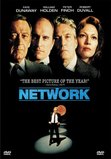
The film, “Network”, written by, Paddy Chayefsky, is a timeless classic. The reason is simple-Chayefsky wrote a perfect four act structure, with turning points every 20 minutes, creating an exemplary piece of intellectual frenzy. The scriptwriter, Robert McKee, would say that the use of narration is a copout; but I believe the VO conveys the boring, indispensable information about television ratings pertinent to the story. Forty years later not much has changed. When we watch the scenes between William Holden and Faye Dunaway and change the word television to Internet, it could be present day. The new generation is growing up in front of smaller screens, but the powers that be have the exact same agenda. Instead of ratings numbers, the buzz words are “friends’, “page visits", and bounce rates.
It’s the small touches throughout the film that I admire, and which made me smile. Max, the character played by Holden, is clearly defined by his Emmy award. The statue is either staged behind his back or is seen in front of him.
Diana, Faye Dunaway’s character, lives with Max in apartment “D”. This letter symbolizes the future and present state of their relationship-doomed or dead. Dead is a better word because Chayefsky, from scene 3, introduces that word into the script through Howard’s line of ‘I’m going to kill myself.’
Another brilliant piece of filmmaking magic is found in the evolution of Max’s wardrobe. From the beginning of the film Max is only seen in solid colored suits. Once he and Susan experience “...many a splendored night.” , his taste in color changes. His trousers and jacket are different colors symbolizing the duality in his life. After the break-up with Susan, he wears a black 3-piece suit in the funeral scene. When they resume their affair and subsequently live together, he chooses again the more casual two tone pattern with contrasting color themes. William Holden is the consummate actor in his choices and I love the “beats” that he takes. When the funeral is over and he spots Susan, he begins walking toward her on the sidewalk. Just before he steps off the curb he takes a half beat. This momentary doubt is symbolic of the conflict he is about to face. When he steps down on the street, he takes a step down in life, as he steps toward the affair that he longs for-“I’m glad I can feel anything.”
Diana is attempting to hail a cab as Max catches up with her. A garbage truck and two school buses pass in front of them, blocking them for a few seconds, The school buses convey how much like children they are. They feel something for each other that they know is wrong, but decide to be reckless and selfish as they pursue each other. The garbage truck hints at where the relationship will end. These small touches are characteristic of how meticulous Sidney Lumet was, and I think that he placed them there on purpose.
William Holden, Peter Finch, Robert Duvall and Ned Beatty are superb in every scene. Beatrice Straight, who plays Max’s wife is simply flawless. In only two scenes, she portrays the character of the loving, heartbroken wife with such tenderness that it makes you cry. I enjoyed Faye Dunaway’s character the last half of the film. In the beginning her performance of the young, excited, producer looking for the next hit show was overacted. I found that it was out of sync with the rest of the cast.
The tempo and rhythm of the editing is ideal. The cinematography is bleached and quite unattractive, Although very few films from the 1970’s have the deep and rich feel of “The Godfather."
4 / 5
Director: Sidney Lumet
Staring: William Holden, Peter Finch, Faye Dunaway, Robert Duvall, Ned Beatty
 RSS Feed
RSS Feed